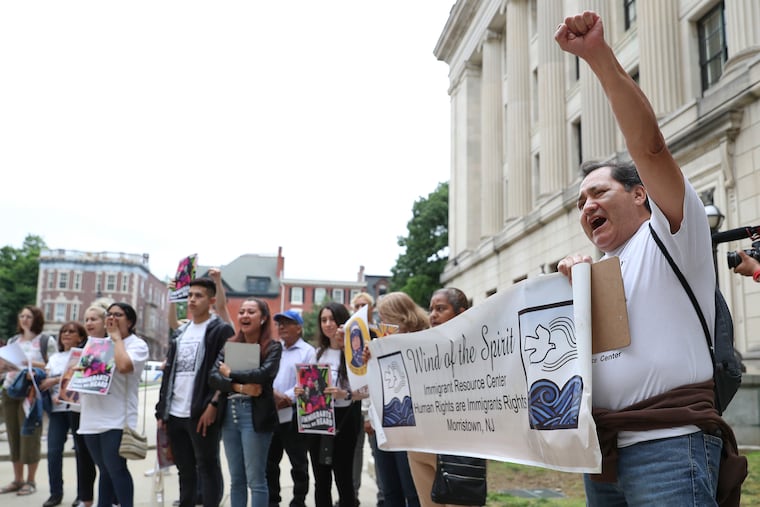In protest and performance, groups demand funding for immigrant communities amid huge N.J. budget surplus
The state’s immigrant population surged 40% between 2000 and 2019, even as the percentage of U.S-born New Jerseyans fell by 2%.

TRENTON – The soaring strains of a mariachi band and the steady bang of a snare drum led a loud combination protest and art performance Wednesday, as activist groups demanded that part of a massive state budget surplus go to help immigrants.
“Happy Immigrant Heritage Month!” shouted Amy Torres, executive director of the New Jersey Alliance for Immigrant Justice, drawing cheers from more than 50 people gathered on the steps of the State House Annex.
“We know why we’re here, but do they know why we’re here?” she asked, pointing behind her at legislative meeting rooms. “We have to take up space here so that we take up space in the budget.”
The response from the crowd inverted the lighted message on the famous bridge: “Immigrants make, Trenton takes,” people chanted.
Nearly one in four New Jersey residents is an immigrant. One in six is a native-born citizen who has at least one immigrant parent, according to the American Immigration Council in Washington.
The state’s immigrant population surged 40% between 2000 and 2019, helping drive population and business growth, even as the number of U.S.-born New Jersey residents dropped 2% during that time.
Now, when the state has billions of extra dollars in hand, immigrant organizations say it’s time to address needs that have been long delayed and denied.
That includes greater protections from actions by federal Immigration and Customs Enforcement, through passage of the Values Act. That law would bar state and local police officials from voluntarily helping U.S. agencies enforce federal immigration law.
Leaders said they want improved language access around the state. And greater use of what’s called data disaggregation, that is, the separation of large statistics into the smaller figures that make them up, thus revealing hidden or underlying trends.
For instance, identifying some immigrants solely as Asian ignores the fact that Asia consists of about 50 countries, each one containing numbers of cultures and ethnicities. Each Asian community in New Jersey can have its own specific needs and challenges, from unemployment to health insurance, but that statistical truth can be hidden in a larger figure.
The Legislature is considering a disaggregation bill, which advocates said is crucial for understanding differences in broader needs among communities in health care, education, and social services.
“We’re not a monolith,” said Laura Choi, a Greenwich Township school board member, leader in Make Us Visible NJ, and a Chinese immigrant who spoke during the rally. “Lumping everyone under the term AAPI does a disservice to our communities.”
Where should the state surplus go, and who should get it, and for what?
“It’s the people’s money — it should go to serve the people,” she said. “And to serve the most vulnerable first.”
In poetry and dance, in caricature signs and spoken chants, the alliance-led protesters sought to contrast the size and diversity of the Garden State’s immigrant population with what they called the continuing underinvestment in those communities.
They said it’s time for elected leaders to stop asking immigrant groups to pick one or two main priorities during budget season, and instead to embrace wide and meaningful change.
“We always talk about the diversity of New Jersey,” said Anjali Mehrotra, who immigrated from India at 19 and is president of the National Organization for Women of New Jersey. “Our governor, our Legislature, [they] embrace it. Now they need to walk the walk.”
Projections show the expected surplus reaching $6.75 billion, according to NJ Spotlight News, and that doesn’t include an additional $5 billion in the state’s “rainy day” fund.
“I’m here to claim this house!” said American Friends Service Committee project leader Serges Demefack, who immigrated from Cameroon, as he gestured at the huge state building. “This house belongs to us!”
People come from around the world to make new lives in New Jersey.
The state is home to 2,074,686 immigrants, fully 23% of the population, according to the Migration Policy Institute in Washington. About 38% of immigrants are Latino, 29% Asian. The biggest sending countries, according to MPI, are India, 268,000; Mexico, 104,230; and China 101,219.
“It’s hard for us to be heard, so we have to find ways to do that,” said Gloria Blanco, who handles public policy and advocacy for Wind of the Spirit, a faith-based immigrant-advocacy organization in Morristown.
The group is pushing hard for passage of the Values Act, knowing the fear that any contact with government or law enforcement can raise in undocumented people, she said.
Blanco, who immigrated from Colombia with her family when she was a child, said that anxiety has lessened under the Biden administration, but the next election could bring leaders who favor the harshest enforcement.
Today the United States is home to a record 44.9 million immigrants, according to MPI. They are 13.7% of the national population, short of the record-high percentage of 14.8% in 1890.
New Jersey, like other coastal states, is a top destination.
Nearly three in five immigrants in New Jersey are naturalized U.S. citizens. Most have pursued college education, with 40% holding a bachelor’s degree or higher, roughly the same as the 41% of U.S.-born New Jersey residents.
In 2018, 136,186 immigrant business owners accounted for 33% of all self-employed New Jersey residents. That year immigrant-led households paid $19.7 billion in federal taxes and $9.5 billion in state and local taxes.
“We are an immigrant state,” said Torres, whose Alliance for Immigrant Justice includes more than 50 labor, faith, policy, and community groups. “Lawmakers need to know that immigrants are here.”